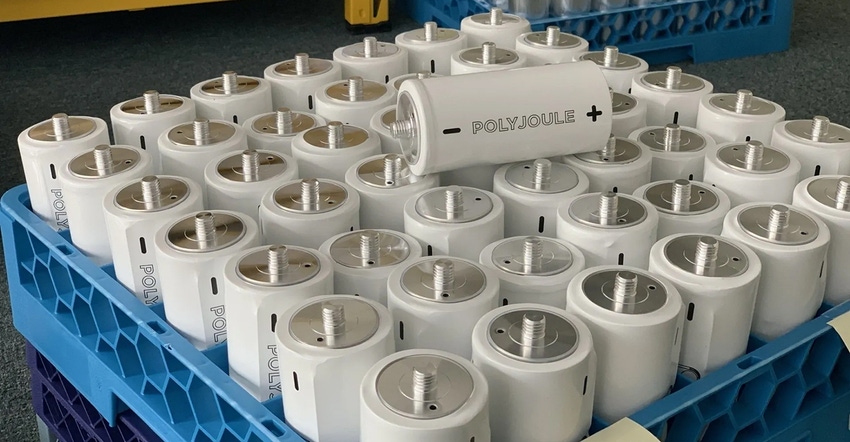Material Advantages of Polymer Batteries
A shift from metal-based batteries could pave the way for renewable-energy storage systems.
September 27, 2022

Wind and solar farms are springing up around the world as the shift away from coal and fossil fuel continues. Alternatives like these are mainly supplemental though, only supplying a small fraction of electricity to the power grid due to their intermittent nature. The excess supply from windmills and solar cells needs to be stored in a way such that it can be easily accessible to the grid when needed, usually in peak demand hours.
Surplus energy is commonly stored in large-scale lithium-ion batteries, but this method brings with it concerns about sustainability. PolyJoule, a Boston-based startup, has a new solution to large-scale battery energy storage systems that addresses these issues by uniquely requiring no metals.
In this article, we’ll discuss energy storage systems, the advantages of PolyJoule’s system, and the potential impact on the industry.
Energy Storage Systems
In the quest for net zero emissions, Battery energy storage systems (BESS) are becoming extremely valuable assets for facilitating the use of renewable energy. A major challenge with renewable energy sources like solar and wind is their non-continuous output: if the wind isn’t gusting or the sky is cloudy, energy isn’t produced. This is where BESS comes in, working to store excess energy during periods of high production to then be used during periods of low production. In this way, as fossil fuel and coal power plants are phased out, stored renewable energy can effectively keep a reliable and steady supply to the power grid.
In addition to the larger grid, BESS have commercial and residential applications. Using advanced software algorithms, these systems choose when to hold and release energy from storage. Releases during high-demand hours are known as peak shaving. This process lowers the amount of energy purchased and eases stress on the grid. As a result, there is a lower chance of power surging and an increase in local grid reliability.
Even beyond the power grid, energy storage can be even more vital. For example, many communities in remote locations and in developing nations rely on decentralized microgrids to provide power. Limited access to roads and long distances required for energy transportation make renewable options a logical choice. The isolated nature of these communities means that robust storage systems are crucial to meeting their needs.
Plastics over Metals
One challenge with developed BESS, however, is that the batteries required for grid energy storage are much larger than those found in electric vehicles. This means they require a much larger amount of lithium, an element that is highly coveted by the automotive and many other industries. For reasons like this, it is expected that EV demand will increase tenfold by 2030, and lithium and other battery metals will follow suit.
In an attempt to avoid this challenge altogether, PolyJoule has developed batteries that are based on plastics instead of metals.
From a supply chain perspective, a major advantage of plastic-based batteries is the fact that the polymers they use can be manufactured from common industrial feedstocks. The result is greater material abundance and ultimately less stress on the supply chain.
Polymer batteries also provide a safety improvement over the current industry standard. While lithium-ion batteries contain flammable liquid electrolytes that aid in the transfer of ions, the fluids needed for a conductive polymer battery are much more inert. Tests have shown that no amount of overcharging, damage, or short circuit can send PolyJoule’s products into thermal runaway. No flammability risk means no costly temperature control system and greater safety for the end users.
Additionally, the nominal operating range for a PolyJoule battery is from -40C to 50C, whereas the average lithium-ion battery can only operate between -20C and 50C. Considering the application of BESS in remote communities that may face extreme heat or extreme cold, the ability of the polymer battery to operate unaffected in harsh conditions without any required climate control system is a big draw. Further, the lifetime of a conductive polymer battery. PolyJoule expects that they can last for over 20 years or 12,000 cycles, which is more than twice the life span of the average lithium-ion battery.
Ramping Up
We are currently experiencing global renewable energy vivification. Target deadlines range from 2030 to 2050 but the goal is the same: use alternative energy sources to reach carbon neutrality.
Battery technology has become a focal point, specifically lithium-ion batteries, but all industries and applications using slight variations of the same batteries will create immense demand and stress on raw materials. Diversified battery technologies like conductive polymers may help expedite the plans and turn carbon neutrality from ideal to reality.
About the Author(s)
You May Also Like





